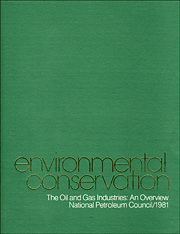|
|
|
Environmental Issues
Charting the Course: Reducing GHG Emissions from the U.S. Natural Gas Supply Chain (2024)
The report, entitled Charting the Course: Reducing GHG Emissions from the U.S. Natural Gas Supply Chain, is the response to the request from the Secretary for the Councils advice on this subject. Natural gas is the largest primary energy produced in the United States and its use is growing. Yet getting this gas to homes and businesses creates greenhouse gas emissions. Thus, reducing emissions from Americas natural gas is an urgent priority that requires collaborative solutions. The National Petroleum Council brought together a diverse group of stakeholders with the expertise to analyze this complex issue and identify ways to reduce natural gas GHG emissions for all future supply and demand scenarios. The result: actionable consensus on ensuring a lower-emission natural gas system. The studys research charts a course forward to meaningfully reduce emissions from the natural gas system, contributing significantly to the United States ability to achieve its climate goals. The report concludes that through the implementation of existing policies, voluntary commitments, technologies, and market mechanisms, a 63 percent reduction in methane emissions can be achieved by 2030. The report went further to identify an additional pathway that methane emissions decrease by 70 percent and carbon dioxide emissions reduce by 33 percent through 2050. The study participants were drawn from NPC members organizations as well as from many other industries, federal, state, and tribal agencies, NGOs, other public-interest groups, financial institutions, consultancies, academia, and research groups. More than 200 people served on the studys committee, subcommittee, task groups, and subgroups. While all have relevant expertise for the study, about half the study members are from the oil and natural gas industry. This broad participation was an integral part of the study with the goal of soliciting input from an informed range of interested parties. To provide interested parties with the ability to review this report and supporting materials in various levels of detail, the report is organized in multiple layers as follows: Report Summary (Volume I) includes the report transmittal letter, outline of the entire report, Preface, Executive Summary, a list of the findings and recommendations of the study, and appendices providing the study request letter, NPC roster, and study group rosters. This volume provides two levels of summarization:
Report Chapters and Appendices (Volume II) includes the five detailed chapters and three substantive appendices for Chapters 2, 3, and 4. SLiNG-GHG Model. To demonstrate an approach that would enable wider use of life cycle assessment (LCA) tools in public policy and corporate strategies across the natural gas supply chain, the NPC supported research by McGill University (Montreal, Quebec, Canada) and the National Renewable Energy Laboratory (NREL, Golden, Colorado, USA) and cooperated in the development of an open-source, user-defined, simplified, and streamlined natural gas well-to-gate life cycle assessment model (SLiNG-GHG) that can generate reasonably representative, screening-level GHG emissions estimates. The SLiNG-GHG model was developed to focus on the key GHG emission sources from the natural gas supply chain, as informed from past published literature as well as subject matter experts involved in the study. By focusing on the key sources of emissions, SLiNG-GHG is easier for non-LCA experts to use. The model and user guide are accessible from the study report website. Topic Papers were prepared to support a detailed review in specific areas. The topic papers are not endorsed or approved by the Council but were approved to be made available as part of the study process (please see the full qualification in the list of topic papers). A list of topic papers is included on the study report website. The Executive Summary, report chapters, and appendices may be individually downloaded from the NPC report website at the NPC report website. The public is welcome and encouraged to visit the site to download the entire report or individual sections for free. Ordering information to purchase copies of Volumes I and II is also available at the NPC report website. Volume I: Report Summary Volume II: Report Chapters Harnessing Hydrogen: A Key Element of the U.S. Energy Future (2024)
The report, entitled Harnessing Hydrogen: A Key Element of the U.S. Energy Future, is the response to the request from the Secretary for the Council’s advice on this subject. If deployed at-scale, low carbon intensity (LCI) hydrogen technology applications in the hard-to-abate sectors can support achieving U.S. carbon emissions reduction ambitions at a lower cost to society. At the request of the Secretary of Energy, the National Petroleum Council conducted a comprehensive study on the deployment of LCI hydrogen at-scale in the United States to support decarbonization of various energy and industrial market sectors across the entire value chain, including production, storage, transportation, and end uses. This study’s report evaluates the key economic, policy, regulatory, technical, and public acceptance challenges and critical enablers along the hydrogen value chain that must be addressed to achieve at-scale LCI hydrogen deployment. The NPC assembled a diverse team of approximately 300 experts from over 100 organizations, 70 percent of which come from outside of the oil and gas industry. This study leveraged scenario-based modeling, partnering with the Massachusetts Institute of Technology Energy Initiative. The study generated unique insights due to the diverse perspectives of the study participants, many of whom have practical experience executing large-scale projects, informing the technoeconomic and life cycle assessment models. To provide interested parties with the ability to review this report and supporting materials in various levels of detail, the report is organized in multiple layers, as follows. Volume I, Report Summary includes the report transmittal letter, outline of the entire report, Preface, Executive Summary, and several appendices. This volume provides three levels of summarization:
Volume II, Analysis of the LCI Hydrogen Value Chain, includes all seven chapters of the report, providing an additional level of detail. Volume III, Supporting Appendices, includes Appendices D through W (Appendices G and N will not be in printed volumes; they are only available via the report website at https://harnessing hydrogen.npc.org). The Executive Summary, report chapters, and appendices may be individually downloaded from the NPC report website. The public is welcome and encouraged to visit the site to download the entire report or individual sections for free. Ordering information to purchase copies of Volumes I, II and III is also available at the NPC report website. Volume I: Report Summary Volume II: Analysis of the LCI Hydrogen Value Chain Volume III: Supporting Appendices Meeting the Dual Challenge: A Roadmap to At-Scale Deployment of Carbon Capture, Use, and Storage (2019)
Carbon capture, use, and storage (CCUS) is essential to meeting the dual challenge of providing affordable, reliable energy while addressing the risks of climate change at the lowest cost. The United States is uniquely positioned as the world leader in CCUS, with approximately 80% of the world’s CCUS capacity and substantial capability to drive widespread deployment in the United States and abroad. Building on expertise and previous research, Meeting the Dual Challenge addresses the entire CCUS supply chain and recognizes that at-scale success requires economic and operational integration across industries, harmonized local/state/federal regulations, innovation and technology development, and broad public acceptance. The report details the actions needed to deploy carbon capture technologies at scale in the United States, an essential climate mitigation technology identified in the majority of global energy outlooks. In the interest of transparency, and to help readers better understand this study, the NPC is making the study results and many of the documents developed by the study groups available to all interested parties. This comprehensive report provides interested parties with the ability to review this report and supporting materials in different levels of detail as follows: Volume I, Summary of Findings and Recommendations, includes the report transmittal letter, outline of the entire report, preface, executive summary, roadmap for enabling the widespread implementation of CCUS at scale, a complete list of the detailed recommendations of the study, and appendices providing the study request letter, NPC rosters, and study group rosters. This volume provides two levels of summarization:
Volume II, Analysis of CCUS Deployment At-Scale, provides more detailed discussion and additional information on the study’s deployment at-scale analyses:
Volume III, Analysis of CCUS Technologies, provides an overview and detailed discussions of the technologies used in the CCUS supply chain.
Topic Papers provide a final level of detail for the reader. These papers, developed or used by the study’s Task Groups, Subgroups, and Teams, are included on the NPC website. They were used in the development of the full report. The Council believes that these materials will be of interest to the readers of the report and will help them better understand the results. The members of the NPC were not asked to endorse or approve all of the statements and conclusions contained in the topic papers but, rather, to approve the publication of these materials as part of the study process. As such, statements and suggested findings that appear in the topic papers are not endorsed by the NPC unless they were incorporated into the report. Cost Curve Model. A differential feature was to assess the costs to capture, transport, and store CO2 from all sectors and fuel types, covering the largest facilities and a total of approximately 80% of all U.S. stationary sources. Using “reference cases” and standard economic assumptions was essential to developing the cost curve, formulating recommendations, and assessing the potential impact of those recommendations on CCUS deployment at a national level. The cost assessment tool used to generate the Cost Curve will allow readers to change the cost and financial assumptions to generate their own view of costs. Printed report: View/Download report: Click here to view/download .pdf versions of each report. The Oil Pollution Act of 1990 – Issues and Solutions (1994)
The report examines the issues involved including: (1) a legal background and history; (2) the potential impacts on U.S. oil and gas production; and (3) impacts on the insurance and financial communities, and other parties. The report presents potential solutions that can be implemented by the MMS and makes recommendations to the Secretary of Energy. Specifically, the report discusses the flexibility available to the MMS in five critical interwoven areas of the OPA financial responsibility rulemaking:
Printed report: (208 pages) Price: $25.00 Click here to view/download .pdf version of final report (10.9 MB)
Environmental Conservation – The report considers three principal areas: current industry operations and the facilities and procedures that are used to protect the environment; the specific areas of environmental law and regulation that have directly affected the availability and cost of petroleum products and natural gas; and significant environmental issues of the 1980s. The report is presented in two parts: the Overview volume published by the NPC in December 1981; and a more detailed volume describing petroleum industry operations and their relationship to environmental quality, which was published by the NPC in mid-1982. The latter volume contains extensive notes and references and is indexed to facilitate its use as a reference document. 1981 - (126 pages) Price: $18.00 Click here to view/download .pdf version of printed report (4.2 MB) 1982 - (688 pages) Price: $36.00 Click here to view/download .pdf version of printed report (23.7 MB) updated 8/12/25
. |
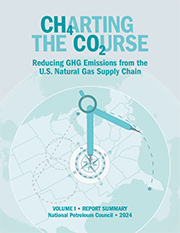
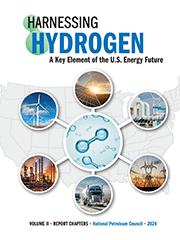
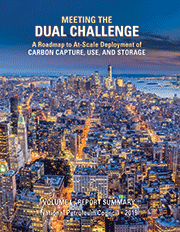
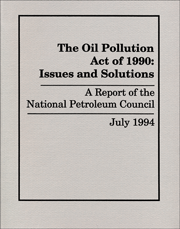 This report presents the Council’s findings regarding the implementation of financial responsibility provisions of the Oil Pollution Act (OPA) as they relate to offshore facilities. The Council has concluded that, properly implemented, OPA could safeguard the public interest by improving oil spill prevention and response without undue harm to the oil and gas industries. However, regulations similar to those outlined by the Minerals Management Service (MMS) in its Advance Notice of Proposed Rulemaking could have serious and substantial impacts on all segments of the oil and gas industries and disrupt commerce in many other areas.
This report presents the Council’s findings regarding the implementation of financial responsibility provisions of the Oil Pollution Act (OPA) as they relate to offshore facilities. The Council has concluded that, properly implemented, OPA could safeguard the public interest by improving oil spill prevention and response without undue harm to the oil and gas industries. However, regulations similar to those outlined by the Minerals Management Service (MMS) in its Advance Notice of Proposed Rulemaking could have serious and substantial impacts on all segments of the oil and gas industries and disrupt commerce in many other areas.